towing JEEP PATRIOT 2021 Owner handbook (in English)
[x] Cancel search | Manufacturer: JEEP, Model Year: 2021, Model line: PATRIOT, Model: JEEP PATRIOT 2021Pages: 332, PDF Size: 1.99 MB
Page 132 of 332
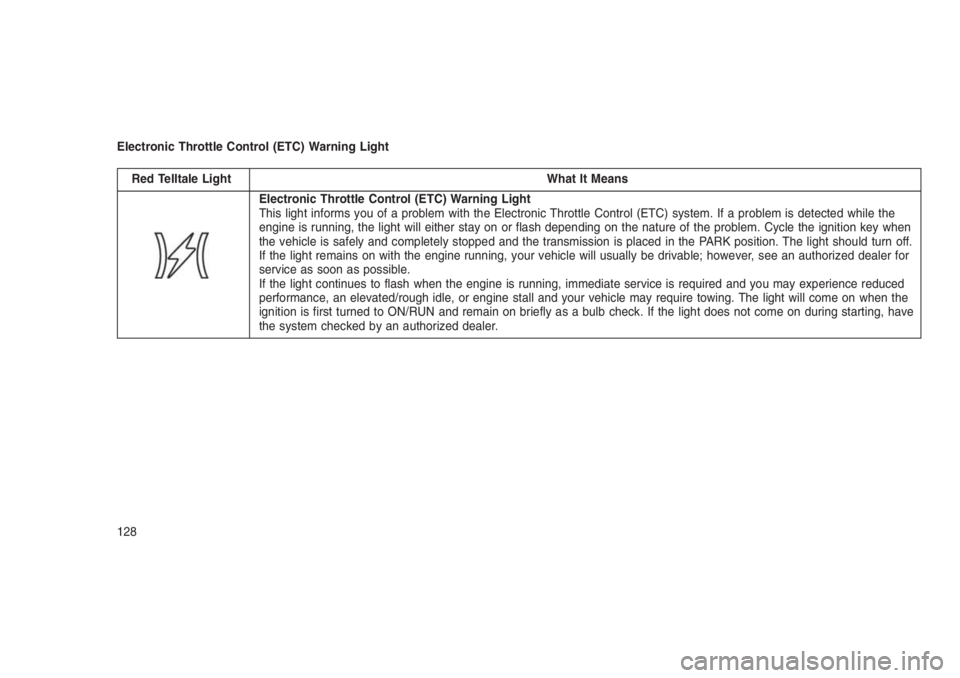
Electronic Throttle Control (ETC) Warning Light
Red Telltale Light What It Means
Electronic Throttle Control (ETC) Warning Light
This light informs you of a problem with the Electronic Throttle Control (ETC) system. If a problem is detected while the
engine is running, the light will either stay on or flash depending on the nature of the problem. Cycle the ignition key when
the vehicle is safely and completely stopped and the transmission is placed in the PARK position. The light should turn off.
If the light remains on with the engine running, your vehicle will usually be drivable; however, see an authorized dealer for
service as soon as possible.
If the light continues to flash when the engine is running, immediate service is required and you may experience reduced
performance, an elevated/rough idle, or engine stall and your vehicle may require towing. The light will come on when the
ignition is first turned to ON/RUN and remain on briefly as a bulb check. If the light does not come on during starting, have
the system checked by an authorized dealer.
128
Page 133 of 332

Yellow Telltale Indicator Lights
Engine Check/Malfunction Indicator Light (MIL)
Yellow Telltale Light What It Means
Engine Check/Malfunction Indicator Light (MIL)The Engine Check/Malfunction Indicator Light (MIL) is a part of an Onboard Diagnostic System called OBD II that monitors en-
gine and automatic transmission control systems. The light will illuminate when the ignition is in the ON position before engine
start. If the bulb does not come on when turning the key from OFF to ON/RUN, have the condition checked promptly.
Certain conditions, such as a loose or missing gas cap, poor quality fuel, etc., may illuminate the light after engine start.
The vehicle should be serviced if the light stays on through several typical driving styles. In most situations, the vehicle will
drive normally and will not require towing.
When the engine is running, the MIL may flash to alert serious conditions that could lead to immediate loss of power or
severe catalytic converter damage. The vehicle should be serviced as soon as possible if this occurs.
CAUTION!
Prolonged driving with the Malfunction Indicator
Light (MIL) on could cause damage to the engine
control system. It also could affect fuel economy
and driveability. If the MIL is flashing, severe
catalytic converter damage and power loss will
soon occur. Immediate service is required.
WARNING!
A malfunctioning catalytic converter, as ref-
erenced above, can reach higher tempera-
tures than in normal operating conditions.
This can cause a fire if you drive slowly or
(Continued)
WARNING!(Continued)
park over flammable substances such as dry
plants, wood, cardboard, etc. This could re-
sult in death or serious injury to the driver,
occupants or others.
129
Page 139 of 332
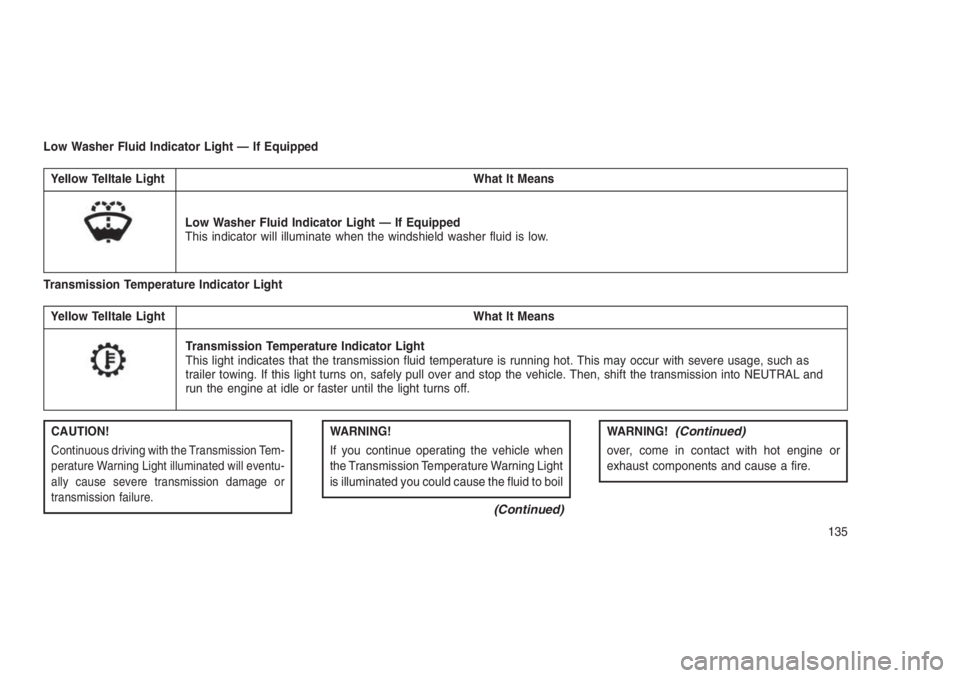
Low Washer Fluid Indicator Light — If Equipped
Yellow Telltale Light What It Means
Low Washer Fluid Indicator Light — If Equipped
This indicator will illuminate when the windshield washer fluid is low.
Transmission Temperature Indicator Light
Yellow Telltale Light What It Means
Transmission Temperature Indicator Light
This light indicates that the transmission fluid temperature is running hot. This may occur with severe usage, such as
trailer towing. If this light turns on, safely pull over and stop the vehicle. Then, shift the transmission into NEUTRAL and
run the engine at idle or faster until the light turns off.
CAUTION!
Continuous driving with the Transmission Tem-
perature Warning Light illuminated will eventu-
ally cause severe transmission damage or
transmission failure.
WARNING!
If you continue operating the vehicle when
the Transmission Temperature Warning Light
is illuminated you could cause the fluid to boil
(Continued)
WARNING!(Continued)
over, come in contact with hot engine or
exhaust components and cause a fire.
135
Page 167 of 332
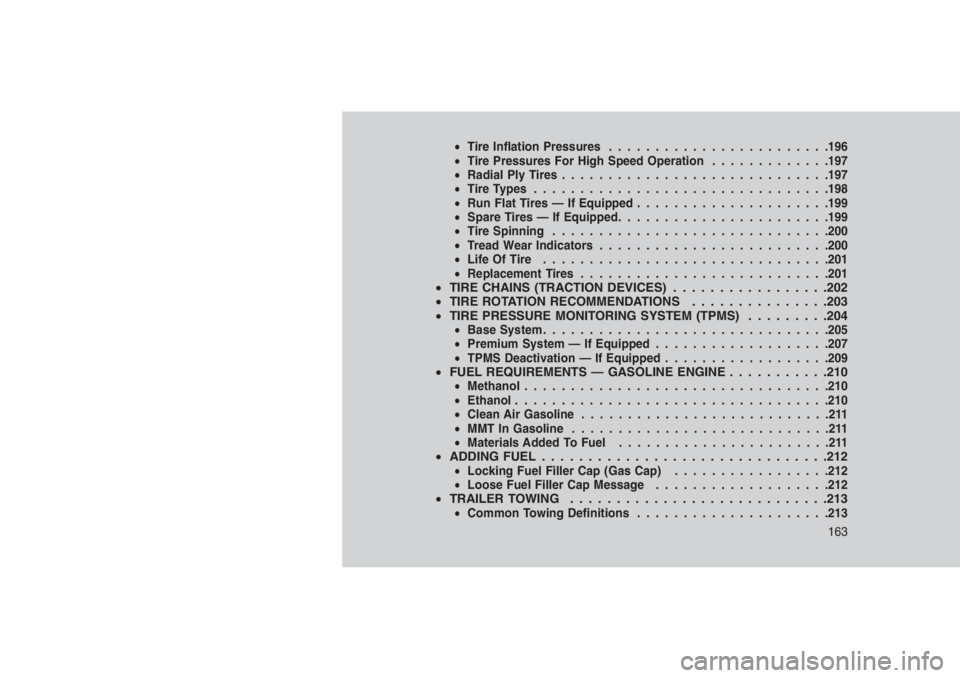
•Tire Inflation Pressures........................196
•Tire Pressures For High Speed Operation.............197
•Radial Ply Tires.............................197
•Tire Types................................198
•Run Flat Tires — If Equipped.....................199
•Spare Tires — If Equipped.......................199
•Tire Spinning..............................200
•Tread Wear Indicators.........................200
•Life Of Tire...............................201
•Replacement Tires...........................201
•TIRE CHAINS (TRACTION DEVICES) . . . . . . . . . . . . .. . . .202
•TIRE ROTATION RECOMMENDATIONS . . . . . . .. . . . . . . .203
•TIRE PRESSURE MONITORING SYSTEM (TPMS) . . . . .. . . .204
•Base System...............................205
•Premium System — If Equipped...................207
•TPMS Deactivation — If Equipped..................209
•FUEL REQUIREMENTS — GASOLINE ENGINE . . . . . . . . . . .210•Methanol.................................210
•Ethanol..................................210
•Clean Air Gasoline...........................211
•MMT In Gasoline............................211
•Materials Added To Fuel.......................211
•ADDING FUEL...............................212•Locking Fuel Filler Cap (Gas Cap).................212
•Loose Fuel Filler Cap Message...................212
•TRAILER TOWING . . ..........................213•Common Towing Definitions.....................213
163
Page 168 of 332
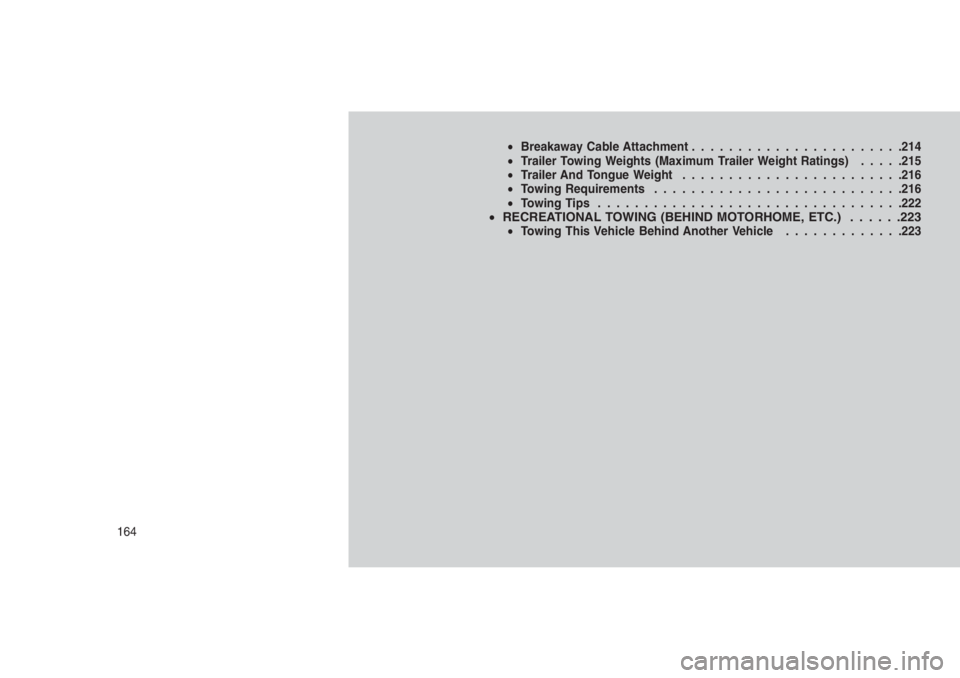
•Breakaway Cable Attachment.......................214
•Trailer Towing Weights (Maximum Trailer Weight Ratings).....215
•Trailer And Tongue Weight........................216
•Towing Requirements...........................216
•Towing Tips.................................222
•RECREATIONAL TOWING (BEHIND MOTORHOME, ETC.)......223•Towing This Vehicle Behind Another Vehicle.............223
164
Page 176 of 332
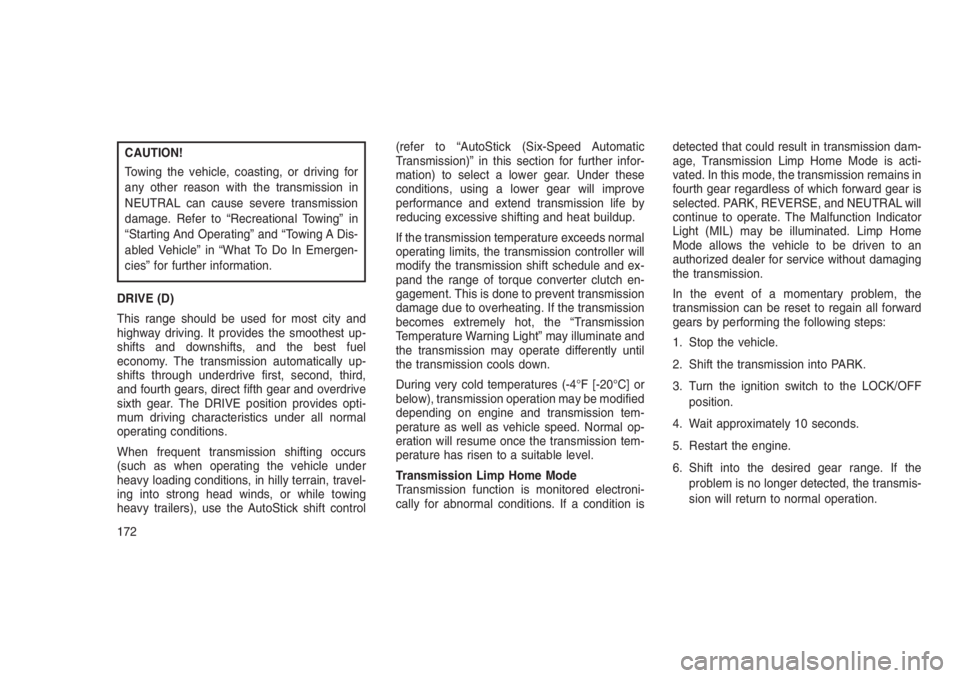
CAUTION!
Towing the vehicle, coasting, or driving for
any other reason with the transmission in
NEUTRAL can cause severe transmission
damage. Refer to “Recreational Towing” in
“Starting And Operating” and “Towing A Dis-
abled Vehicle” in “What To Do In Emergen-
cies” for further information.
DRIVE (D)
This range should be used for most city and
highway driving. It provides the smoothest up-
shifts and downshifts, and the best fuel
economy. The transmission automatically up-
shifts through underdrive first, second, third,
and fourth gears, direct fifth gear and overdrive
sixth gear. The DRIVE position provides opti-
mum driving characteristics under all normal
operating conditions.
When frequent transmission shifting occurs
(such as when operating the vehicle under
heavy loading conditions, in hilly terrain, travel-
ing into strong head winds, or while towing
heavy trailers), use the AutoStick shift control(refer to “AutoStick (Six-Speed Automatic
Transmission)” in this section for further infor-
mation) to select a lower gear. Under these
conditions, using a lower gear will improve
performance and extend transmission life by
reducing excessive shifting and heat buildup.
If the transmission temperature exceeds normal
operating limits, the transmission controller will
modify the transmission shift schedule and ex-
pand the range of torque converter clutch en-
gagement. This is done to prevent transmission
damage due to overheating. If the transmission
becomes extremely hot, the “Transmission
Temperature Warning Light” may illuminate and
the transmission may operate differently until
the transmission cools down.
During very cold temperatures (-4°F [-20°C] or
below), transmission operation may be modified
depending on engine and transmission tem-
perature as well as vehicle speed. Normal op-
eration will resume once the transmission tem-
perature has risen to a suitable level.
Transmission Limp Home Mode
Transmission function is monitored electroni-
cally for abnormal conditions. If a condition isdetected that could result in transmission dam-
age, Transmission Limp Home Mode is acti-
vated. In this mode, the transmission remains in
fourth gear regardless of which forward gear is
selected. PARK, REVERSE, and NEUTRAL will
continue to operate. The Malfunction Indicator
Light (MIL) may be illuminated. Limp Home
Mode allows the vehicle to be driven to an
authorized dealer for service without damaging
the transmission.
In the event of a momentary problem, the
transmission can be reset to regain all forward
gears by performing the following steps:
1. Stop the vehicle.
2. Shift the transmission into PARK.
3. Turn the ignition switch to the LOCK/OFF
position.
4. Wait approximately 10 seconds.
5. Restart the engine.
6. Shift into the desired gear range. If the
problem is no longer detected, the transmis-
sion will return to normal operation.
172
Page 179 of 332
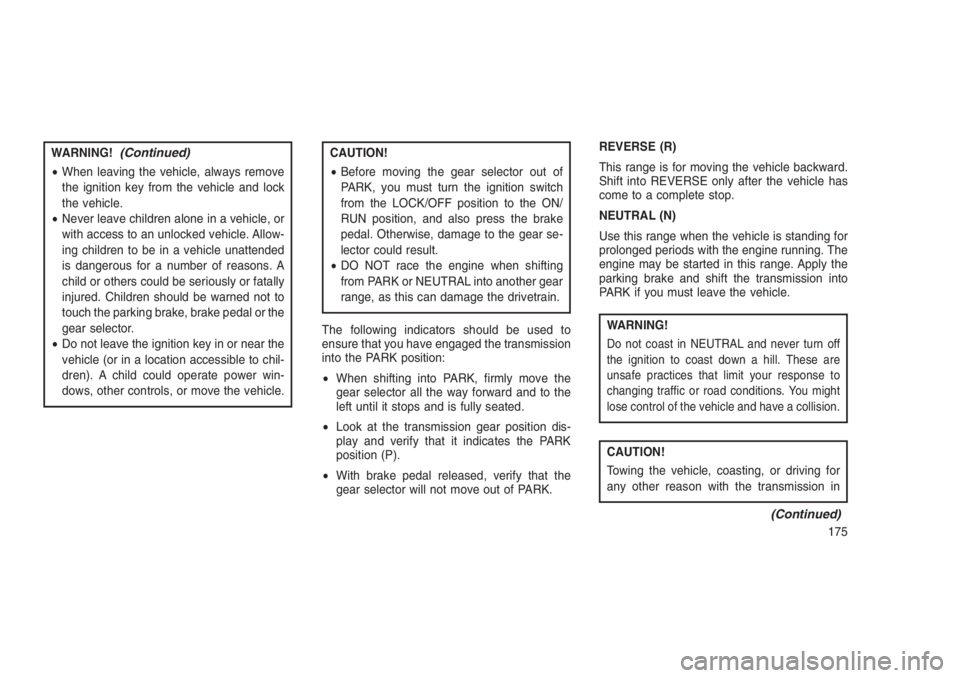
WARNING!(Continued)
•When leaving the vehicle, always remove
the ignition key from the vehicle and lock
the vehicle.
•Never leave children alone in a vehicle, or
with access to an unlocked vehicle. Allow-
ing children to be in a vehicle unattended
is dangerous for a number of reasons. A
child or others could be seriously or fatally
injured. Children should be warned not to
touch the parking brake, brake pedal or the
gear selector.
•Do not leave the ignition key in or near the
vehicle (or in a location accessible to chil-
dren). A child could operate power win-
dows, other controls, or move the vehicle.
CAUTION!
•Before moving the gear selector out of
PARK, you must turn the ignition switch
from the LOCK/OFF position to the ON/
RUN position, and also press the brake
pedal. Otherwise, damage to the gear se-
lector could result.
•DO NOT race the engine when shifting
from PARK or NEUTRAL into another gear
range, as this can damage the drivetrain.
The following indicators should be used to
ensure that you have engaged the transmission
into the PARK position:
•When shifting into PARK, firmly move the
gear selector all the way forward and to the
left until it stops and is fully seated.
•Look at the transmission gear position dis-
play and verify that it indicates the PARK
position (P).
•With brake pedal released, verify that the
gear selector will not move out of PARK.REVERSE (R)
This range is for moving the vehicle backward.
Shift into REVERSE only after the vehicle has
come to a complete stop.
NEUTRAL (N)
Use this range when the vehicle is standing for
prolonged periods with the engine running. The
engine may be started in this range. Apply the
parking brake and shift the transmission into
PARK if you must leave the vehicle.
WARNING!
Do not coast in NEUTRAL and never turn off
the ignition to coast down a hill. These are
unsafe practices that limit your response to
changing traffic or road conditions. You might
lose control of the vehicle and have a collision.
CAUTION!
Towing the vehicle, coasting, or driving for
any other reason with the transmission in
(Continued)
175
Page 180 of 332
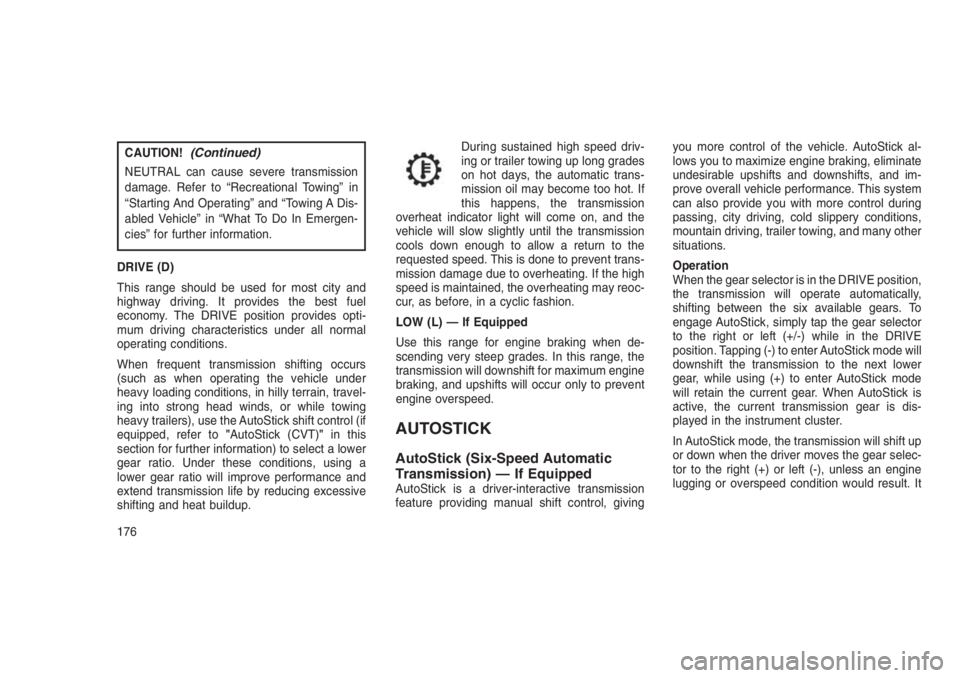
CAUTION!(Continued)
NEUTRAL can cause severe transmission
damage. Refer to “Recreational Towing” in
“Starting And Operating” and “Towing A Dis-
abled Vehicle” in “What To Do In Emergen-
cies” for further information.
DRIVE (D)
This range should be used for most city and
highway driving. It provides the best fuel
economy. The DRIVE position provides opti-
mum driving characteristics under all normal
operating conditions.
When frequent transmission shifting occurs
(such as when operating the vehicle under
heavy loading conditions, in hilly terrain, travel-
ing into strong head winds, or while towing
heavy trailers), use the AutoStick shift control (if
equipped, refer to"AutoStick (CVT)"in this
section for further information) to select a lower
gear ratio. Under these conditions, using a
lower gear ratio will improve performance and
extend transmission life by reducing excessive
shifting and heat buildup.During sustained high speed driv-
ing or trailer towing up long grades
on hot days, the automatic trans-
mission oil may become too hot. If
this happens, the transmission
overheat indicator light will come on, and the
vehicle will slow slightly until the transmission
cools down enough to allow a return to the
requested speed. This is done to prevent trans-
mission damage due to overheating. If the high
speed is maintained, the overheating may reoc-
cur, as before, in a cyclic fashion.
LOW (L) — If Equipped
Use this range for engine braking when de-
scending very steep grades. In this range, the
transmission will downshift for maximum engine
braking, and upshifts will occur only to prevent
engine overspeed.
AUTOSTICK
AutoStick (Six-Speed Automatic
Transmission) — If Equipped
AutoStick is a driver-interactive transmission
feature providing manual shift control, givingyou more control of the vehicle. AutoStick al-
lows you to maximize engine braking, eliminate
undesirable upshifts and downshifts, and im-
prove overall vehicle performance. This system
can also provide you with more control during
passing, city driving, cold slippery conditions,
mountain driving, trailer towing, and many other
situations.
Operation
When the gear selector is in the DRIVE position,
the transmission will operate automatically,
shifting between the six available gears. To
engage AutoStick, simply tap the gear selector
to the right or left (+/-) while in the DRIVE
position. Tapping (-) to enter AutoStick mode will
downshift the transmission to the next lower
gear, while using (+) to enter AutoStick mode
will retain the current gear. When AutoStick is
active, the current transmission gear is dis-
played in the instrument cluster.
In AutoStick mode, the transmission will shift up
or down when the driver moves the gear selec-
tor to the right (+) or left (-), unless an engine
lugging or overspeed condition would result. It
176
Page 181 of 332
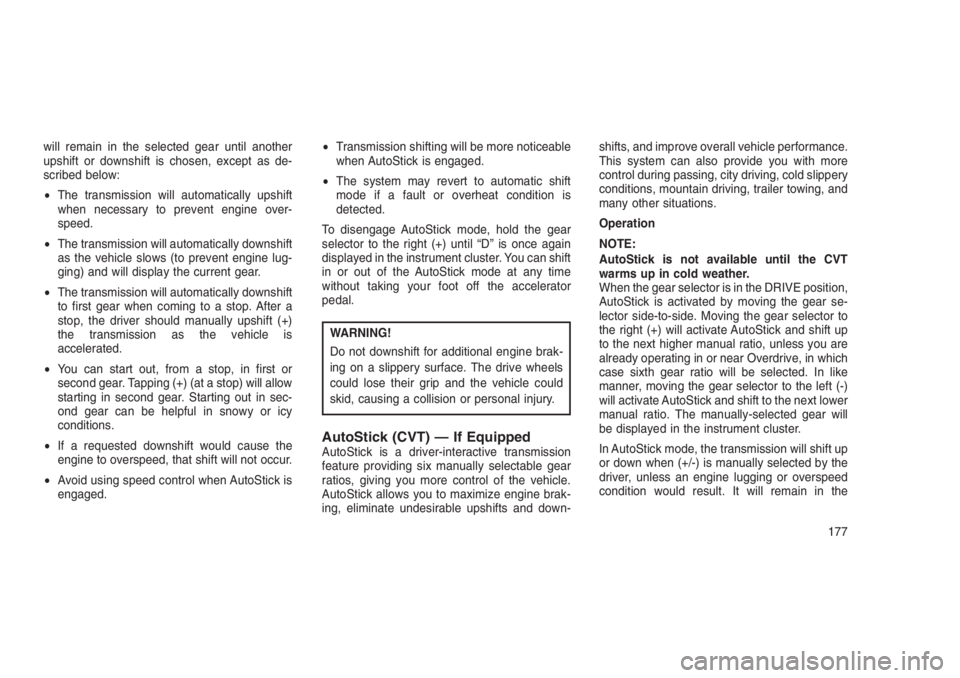
will remain in the selected gear until another
upshift or downshift is chosen, except as de-
scribed below:
•The transmission will automatically upshift
when necessary to prevent engine over-
speed.
•The transmission will automatically downshift
as the vehicle slows (to prevent engine lug-
ging) and will display the current gear.
•The transmission will automatically downshift
to first gear when coming to a stop. After a
stop, the driver should manually upshift (+)
the transmission as the vehicle is
accelerated.
•You can start out, from a stop, in first or
second gear. Tapping (+) (at a stop) will allow
starting in second gear. Starting out in sec-
ond gear can be helpful in snowy or icy
conditions.
•If a requested downshift would cause the
engine to overspeed, that shift will not occur.
•Avoid using speed control when AutoStick is
engaged.•Transmission shifting will be more noticeable
when AutoStick is engaged.
•The system may revert to automatic shift
mode if a fault or overheat condition is
detected.
To disengage AutoStick mode, hold the gear
selector to the right (+) until “D” is once again
displayed in the instrument cluster. You can shift
in or out of the AutoStick mode at any time
without taking your foot off the accelerator
pedal.
WARNING!
Do not downshift for additional engine brak-
ing on a slippery surface. The drive wheels
could lose their grip and the vehicle could
skid, causing a collision or personal injury.
AutoStick (CVT) — If EquippedAutoStick is a driver-interactive transmission
feature providing six manually selectable gear
ratios, giving you more control of the vehicle.
AutoStick allows you to maximize engine brak-
ing, eliminate undesirable upshifts and down-shifts, and improve overall vehicle performance.
This system can also provide you with more
control during passing, city driving, cold slippery
conditions, mountain driving, trailer towing, and
many other situations.
Operation
NOTE:
AutoStick is not available until the CVT
warms up in cold weather.
When the gear selector is in the DRIVE position,
AutoStick is activated by moving the gear se-
lector side-to-side. Moving the gear selector to
the right (+) will activate AutoStick and shift up
to the next higher manual ratio, unless you are
already operating in or near Overdrive, in which
case sixth gear ratio will be selected. In like
manner, moving the gear selector to the left (-)
will activate AutoStick and shift to the next lower
manual ratio. The manually-selected gear will
be displayed in the instrument cluster.
In AutoStick mode, the transmission will shift up
or down when (+/-) is manually selected by the
driver, unless an engine lugging or overspeed
condition would result. It will remain in the
177
Page 194 of 332
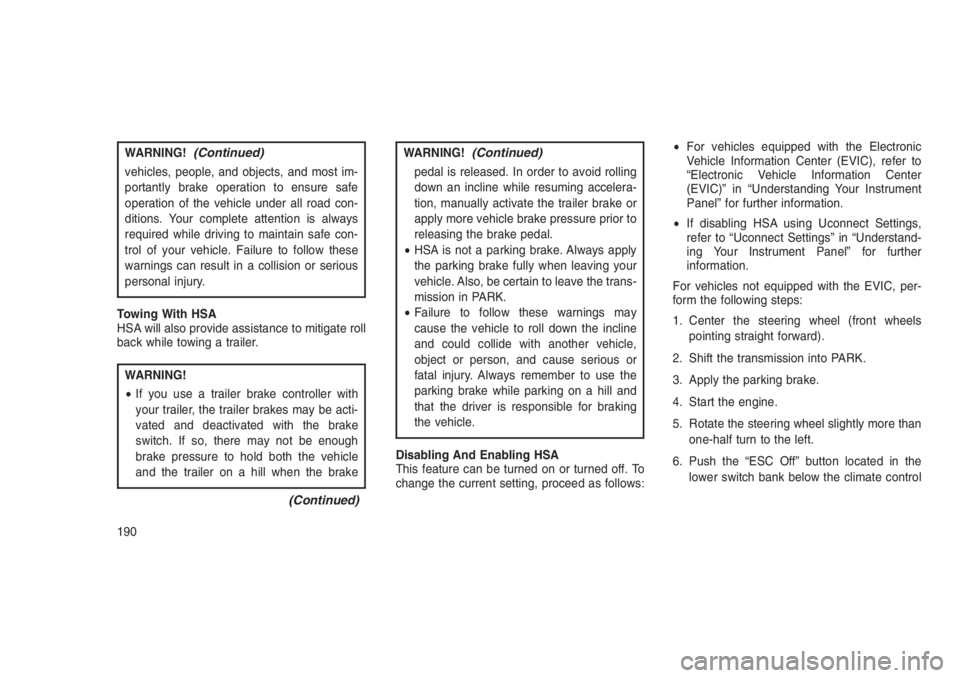
WARNING!(Continued)
vehicles, people, and objects, and most im-
portantly brake operation to ensure safe
operation of the vehicle under all road con-
ditions. Your complete attention is always
required while driving to maintain safe con-
trol of your vehicle. Failure to follow these
warnings can result in a collision or serious
personal injury.
Towing With HSA
HSA will also provide assistance to mitigate roll
back while towing a trailer.
WARNING!
•If you use a trailer brake controller with
your trailer, the trailer brakes may be acti-
vated and deactivated with the brake
switch. If so, there may not be enough
brake pressure to hold both the vehicle
and the trailer on a hill when the brake
(Continued)
WARNING!(Continued)
pedal is released. In order to avoid rolling
down an incline while resuming accelera-
tion, manually activate the trailer brake or
apply more vehicle brake pressure prior to
releasing the brake pedal.
•HSA is not a parking brake. Always apply
the parking brake fully when leaving your
vehicle. Also, be certain to leave the trans-
mission in PARK.
•Failure to follow these warnings may
cause the vehicle to roll down the incline
and could collide with another vehicle,
object or person, and cause serious or
fatal injury. Always remember to use the
parking brake while parking on a hill and
that the driver is responsible for braking
the vehicle.
Disabling And Enabling HSA
This feature can be turned on or turned off. To
change the current setting, proceed as follows:•For vehicles equipped with the Electronic
Vehicle Information Center (EVIC), refer to
“Electronic Vehicle Information Center
(EVIC)” in “Understanding Your Instrument
Panel” for further information.
•If disabling HSA using Uconnect Settings,
refer to “Uconnect Settings” in “Understand-
ing Your Instrument Panel” for further
information.
For vehicles not equipped with the EVIC, per-
form the following steps:
1. Center the steering wheel (front wheels
pointing straight forward).
2. Shift the transmission into PARK.
3. Apply the parking brake.
4. Start the engine.
5. Rotate the steering wheel slightly more than
one-half turn to the left.
6. Push the “ESC Off” button located in the
lower switch bank below the climate control
190